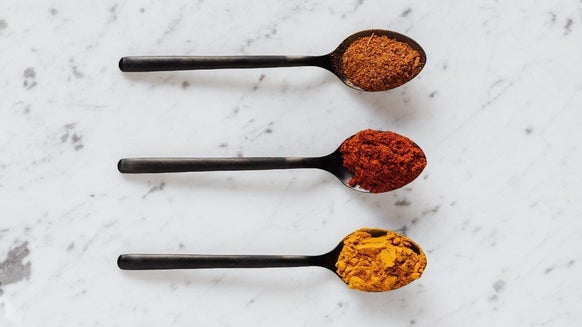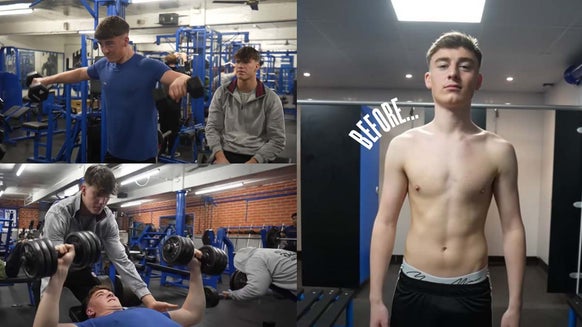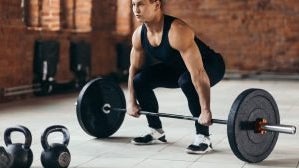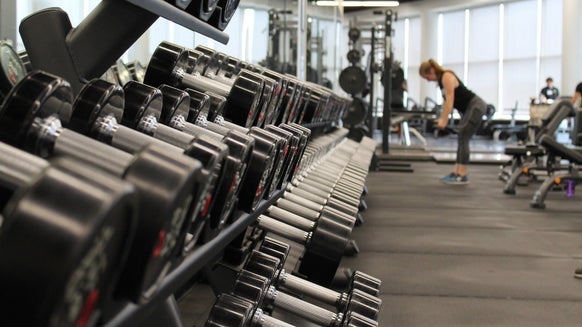Leg Workouts for Women at Home or the Gym
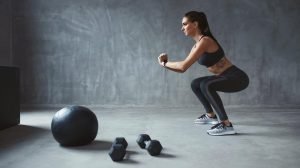
With the current situation of never-ending lockdowns limiting gyms from reopening, many people are wondering if and how they can keep their hard-earned gains and stay in good shape at home. While it may be a bit more difficult to get motivated, it’s certainly not impossible to get an effective and fun workout in if you know what exercises you can do. This article will give you all the tools you need to build muscle at home and stay fit!
Leg Workout - No Equipment
For this workout, all you’ll need is appropriate space and something to provide some elevation for some of the exercises, like the stairs or a chair. The duration will depend on a few factors – whether you want to increase the difficulty of the session by increasing the number of sets and reps, the rest time between sets, and the speed you execute each exercise. Expect this session to take around 30-60 minutes.
Bodyweight Squats
Sets and Reps: 3x12
Technique: Stand with your feet around shoulder-width apart in a comfortable position – this may mean a slightly wider or narrower stance with your feet facing straight on or turned outwards at more of an angle. With your spine in a neutral (straight/erect) position, bend at the hips and knees at the same time. Descend into the bottom of the squat position (for some, this may be most comfortable with your femurs/upper leg parallel to the ground, for others this may be deeper to the point that your hamstrings meet your calves). Without allowing your knees to cave inwards or your chest to drop forwards, push with your weight over the centre of your foot until you are standing back in the start position. Squeeze your glutes together, then initiate the next rep.
Any variation of a squat is great for building muscle and adding shape to the quadriceps and the glutes, which are not only a sought-after aesthetic goal for many, but they also contribute greatly to sports performance.
Bulgarian Split Squats
Sets and Reps: 3x12
Technique: Standing in a lunge stance, elevate your rear foot to around knee height using a step or chair. Maintaining an upright torso and with your stance width around shoulder-width apart (or slightly wider), lower your rear knee towards the ground until you feel a stretch in the quads of the rear leg. Without allowing your knee to touch the ground, push back up to the start position and initiate the next rep.
This exercise is great for developing muscular endurance and strength in the quads and glutes unilaterally. This exercise is also a favourite for hypertrophic development due to how taxing it is on the glutes and quads.
Glute Bridges
Sets and Reps: 3x15
Technique: Lying flat with your back on the ground (or with your torso elevated by lying back onto a chair or platform), move your feet towards your hips until your shins are perpendicular to the floor. The contact points with the ground should be your feet, upper back, head and (in the starting position) your glutes. Maintaining a neutral spine, push your hips up towards the ceiling, squeezing your glutes firmly at the top of the movement for around 2-3 seconds before releasing and lowering back to the start position in a controlled manner.
As is suggested by the name, glute bridges are great at developing size and strength in the glutes by loading the hip extension. This exercise is great, whether your goals are for aesthetic or athletic reasons.
Hamstring Sliders
Sets and Reps: 4x8
Technique: For this exercise, you’ll need a slick surface like a laminate floor or wooden floor. You’ll also need to wear socks or put a piece of cloth between your heels and the floor so that you are able to slide (a skateboard is also great for this if you have one!). Lie on your back with your heels pressed into the ground. Slide/drag your heels up towards your hips, allowing them to slide on the fabric/laminate. Once your knees are fully flexed, slide them back to the start position.
This is a great substitute for hamstring curls to develop hamstring strength that you may otherwise do in the gym. Don’t forget, it’s important to try and balance the amount of volume that you put your hamstrings through as you do for your quads too!
Deficit Calf Raises
Sets and Reps: 3x15
Technique: Standing on the edge of a step, with your heels hanging over the edge, allow your heels to drop down as far as you can go, before pushing all the way up onto your tiptoes. Squeeze at the top for around 2 seconds.
Try this one with your knees both straight and bent, as these variations will preferentially work the two main muscles in your calves.
Side-Lying Hip Abduction
Sets and Reps: 3x12
Technique: Lying on your side and with your legs straight, lift the top leg away (known as abduction), before slowly lowering back down to the start position. Try with a bent knee to regress the exercise and make it a bit easier.
This exercise may seem easy, but it can quickly become a challenge as it requires some of the smaller muscles at your hips to work hard. This is great for developing the gluteus medius muscle that supports your hips in other exercises.
Tuck Jumps
Sets and Reps: 4x6
Technique: Start standing upright, then quickly drop into a partial squat before powerfully jumping straight up. Once in the air, tuck your knees up towards your chest, then extend your legs back down to prepare to land. Try not to let your knees cave inwards as you push off during the jump!
This exercise is a great way of developing the power in your legs (and might also prove to be quite fatiguing to your hip flexors!), which can have a good carry-over to your strength in other exercises.
Nordic Hamstring Curls
Sets and Reps: 4x3
Technique: Have a partner assist you with this one by pinning your ankles down. Start by kneeling, with your hips extended and your back in a neutral position. You might want a towel to provide some cushioning between your knees and the floor. With your partner securing your ankles down, allow your upper body to ‘fall’ forwards, but slow your descent by contracting your hamstrings. Challenge yourself by seeing how close to the ground you can get before your hamstrings give up!
This exercise is great for developing strength in your hamstrings, which can ultimately help to protect against injuries like hamstring strains, which is particularly useful if you participate in some sort of team sport or track athletics.
Leg Workout with Resistance Bands
Resistance bands can offer an affordable, portable, and convenient solution to home workouts, allowing you to add some more resistance to your sessions beyond your own bodyweight. This session should take around 45 minutes to complete.
Kang Squats
Sets and Reps: 4x15
Technique: Loop the resistance band under your feet whilst standing in a normal squat stance, then loop the other end around the back of your neck/shoulders. For this squat variant, break at your hips first (similar to a deadlift), then once your torso is parallel to the ground, break at your knees so that you fold into the bottom of a normal squat. To complete the rep, either perform the same but in reverse or simply stand up from the bottom of the squat against the resistance of the band.
This exercise provides a great way to load your hip muscles and can also challenge your mobility. Your hamstrings, glutes and quads will all be challenged with this squat variant.
Hamstring Curls
Sets and Reps: 4x10
Technique: Anchor one end of the resistance band to a stable object (like the end pillar at the bottom of your stairs), then loop the other end around your ankle. Step back so that there is a moderate amount of tension on the band, then flex your knee as you would for a normal hamstring curl machine at the gym. Squeeze at the end, then slowly return to the start position before the next rep.
It’s important to provide enough stimulus to your hamstrings as well as your quads when training, and this exercise provides the perfect solution to that when training at home. This can be an effective exercise for gaining muscle mass, strength, and endurance in the hamstrings.
Leg Extensions
Sets and Reps: 4x10
Technique: Sitting on a chair, anchor the resistance band to one of the chair legs and around your ankle. Keeping your bottom on the seat, kick your foot forwards until your leg is straight or nearly straight. Squeeze at the end of range of movement, then return to the start position in a controlled manner.
This exercise is a great way to overload your quadriceps, providing additional stimulus via an accessory exercise to help your muscles grow.
Standing Hip Abduction
Sets and Reps: 4x12
Technique: Anchor one end of the resistance band to a stable object, with the other end looped around your ankle/lower leg. Stand so that the band crosses your body as the band needs to be attached to the leg furthest from the anchor point. Step away enough that there is a moderate amount of tension on the band, then abduct your leg away, holding for 2 seconds before returning to the start position in a controlled manner.
This exercise helps to develop strength and muscle mass in the gluteus medius, which is responsible for stabilising the leg during activities like running and squatting, ultimately helping to protect against injuries.
Standing Hip Adduction
Sets and Reps: 4x12
Technique: Set up the same as the previous exercise but position your body so that the band does not cross your body and is attached to the leg closest to the anchor point. Stand so that there is a moderate amount of tension on the band, then adduct your leg across your body. For an additional range of movement in this exercise, start with your legs standing further apart. This exercise helps to develop strength in the adductors on the inside of your leg, which contribute to sporting performance and provide additional stability to heavy compound resistance training exercises.
Donkey Kick Backs
Sets and Reps: 3x10
Technique: Start on all fours with the band looped around your hands which are in contact with the ground. Loop the other end around the sole of one of your feet. Proceed to ‘kickback’ with this leg, extending fully at your hip. Squeeze at the end of the range of movement before returning to the start position in a controlled manner.
This exercise loads the glutes unilaterally, so it’s a good tool to use if the only resistance you have available to you is the resistance bands.
Leg Workout with Weights
Whether you have access to dumbbells, kettlebells, barbells or more, using free-weights provides a highly versatile method of resistance training, with endless exercises available at your disposal. Depending on whether you alter the sets and reps and the amount of rest you take between sets, this session will take around 60 minutes to complete.
Goblet Squat
Sets and Reps: 4x10
Technique: Start standing upright and hold the weight to your chest using both hands, making a ‘V’ shape with the heels of your hands near each other. Proceed to perform a normal squat, keeping your chest up and back straight throughout the lift.
Similar to a front squat, this exercise is good for loading the quads and glutes, so most of the muscle development will happen there. This type of exercise also challenges the core muscle to stabilise the spine throughout the lift.
Bulgarian Split Squats
Sets and Reps: 3x12
Technique: Standing in a lunge stance, elevate your rear foot to around knee height using a step or chair. Hold the weights in one or both hands (depending on which you find easier to balance). Maintaining an upright torso and with your stance width around shoulder-width apart (or slightly wider), lower your rear knee towards the ground until you feel a stretch in the quads of the rear leg. Without allowing your knee to touch the ground, push back up to the start position and initiate the next rep.
This exercise is great for developing muscular endurance and strength in the quads and glutes unilaterally. This exercise is also a favourite for hypertrophic development due to how taxing it is on the glutes and quads.
Hip Thrusts
Sets and Reps: 3x15
Technique: Lying flat with your back on the ground (or with your torso elevated by lying back onto a chair or platform), move your feet towards your hips until your shins are perpendicular to the floor. The contact points with the ground should be your feet, upper back, head and (in the starting position) your glutes. Place the weight in your hip crease in a comfortable position (use something as padding like a towel if you find it too uncomfortable). Maintaining a neutral spine, push your hips up towards the ceiling, squeezing your glutes firmly at the top of the movement for around 2-3 seconds before releasing and lowering back to the start position in a controlled manner.
As is suggested by the name, glute bridges are great at developing size and strength in the glutes by loading hip extension. This exercise is great, whether your goals are for aesthetic or athletic reasons.
Romanian Deadlift
Sets and Reps: 3x12
Technique: Start standing upright with the weight held at your sides/just in front of your legs. With a slight bend in the knees, break only at the hips and descend until you feel a stretch in your hamstrings. Make sure you keep the weight close to your body throughout and maintain a neutral spine. Once you feel a decent stretch in your hamstrings, return to the start position by contracting your hamstrings and glutes.
This exercise is fantastic for developing strength in your hamstrings and glutes when done properly, and also helps to add strength and stability to your lower back muscles as they must work hard to maintain a neutral spine throughout the lift.
Walking Lunges
Sets and Reps: 3x15
Technique: Start standing upright, holding the weights in either hand. Step forward into a lunge stance (make sure that your stance is wide enough that you don’t lose balance). From here, either step back to a neutral position or just swing straight through with the other leg, so that the opposite leg is performing a lunge in succession. Continue this until you have completed your set. Keep your torso upright throughout with a neutral spine and try not to swing the weights.
This exercise develops the glutes, quads and is particularly transferrable to sporting performance due to how it loads the legs unilaterally.
Gym Leg Workout
Working out in the gym (we all miss it!), the equipment required should be available to you unless it is in use. This workout may take between 45 and 90 minutes depending on the number of sets and reps performed and the amount of rest taken between each set. Feel free to adjust the workout, eliminating or adding different exercises and varying set/rep schemes.
Barbell Squats
Sets and Reps: 3x12
Technique: Stand with your feet around shoulder-width apart in a comfortable position – this may mean a slightly wider or narrower stance with your feet facing straight on or turned outwards at more of an angle. With your spine in a neutral (straight/erect) position, bend at the hips and knees at the same time. Descend into the bottom of the squat position (for some, this may be most comfortable with your femurs/upper leg parallel to the ground, for others this may be deeper to the point that your hamstrings meet your calves). Without allowing your knees to cave inwards or your chest to drop forwards, push with your weight over the centre of your foot until you are standing back in the start position. Squeeze your glutes together, then initiate the next rep.
Romanian Deadlift
Sets and Reps: 3x12
Technique: Start standing upright with the weight held at your sides/just in front of your legs. With a slight bend in the knees, break only at the hips and descend until you feel a stretch in your hamstrings. Make sure you keep the weight close to your body throughout and maintain a neutral spine. Once you feel a decent stretch in your hamstrings, return to the start position by contracting your hamstrings and glutes.
This exercise is fantastic for developing strength in your hamstrings and glutes when done properly, and also helps to add strength and stability to your lower back muscles as they must work hard to maintain a neutral spine throughout the lift.
Hip Thrusts
Sets and Reps: 3x15
Technique: Lying flat with your back on the ground (or with your torso elevated by lying back onto a chair or platform), move your feet towards your hips until your shins are perpendicular to the floor. The contact points with the ground should be your feet, upper back, head and (in the starting position) your glutes. Place the weight in your hip crease in a comfortable position (use something as padding like a towel if you find it too uncomfortable). Maintaining a neutral spine, push your hips up towards the ceiling, squeezing your glutes firmly at the top of the movement for around 2-3 seconds before releasing and lowering back to the start position in a controlled manner.
As is suggested by the name, glute bridges are great at developing size and strength in the glutes by loading hip extension. This exercise is great, whether your goals are for aesthetic or athletic reasons.
Leg Extensions
Sets and Reps: 4x10
Technique: Set the machine with an appropriate load and adjust the pad so it is in contact with your lower shin. Kick your feet forwards until your legs are fully extended, then squeeze your quads for around 2 seconds before returning to the start position in a controlled manner. If necessary, hold on to the handles at the sides of the seat during the exercise so that you are not lifted away from the seat.
This exercise is a useful tool for introducing additional stimulus to the quadriceps in a safe manner once they are fatigued (i.e. this exercise is low risk compared to performing more free weights exercises as accessories once your quadriceps are fatigued). This type of exercise allows you to focus and develop one singular muscle group – the knee extensors.
Hamstring Curls
Sets and Reps: 4x10
Technique: Set the machine to an appropriate load and adjust the pad so that it is in contact with you lower shin. Pull your feet towards your glutes, squeezing your hamstrings throughout, then return to the start position in a slow and controlled manner.
Similar to the leg extension, this exercise offers an easier way to isolate the knee flexors (hamstrings) once they have been fatigued by other compound lifts.
Leg Press
Sets and Reps: 3x8
Technique: Load the machine appropriately for your ability then get set in the machine with your feet in a similar stance to what you find comfortable when squatting. Un-rack the load and lower it to a similar depth that you would go to when squatting (it’s easy to allow your lower back to round when using a leg press – avoid this by only going to a ‘safe’ depth). Press the load back to the start position but keep ‘soft knees’ (i.e. don’t lock your knees out, as this machine makes it all too easy to hyperextend your knee joint and cause injury).
Hip Abduction Machine
Sets and Reps: 4x12
Technique: Select and appropriate load and start with your knees together. Open your legs against the resistance of the machine, then slowly return to the start position in a controlled manner.
This exercise heavily loads the gluteus medius muscle that is primarily responsible for the movement of hip abduction. This will have a strong carryover to your performance in other exercises and also helps to add muscle mass to your glutes.
Calf Raise Machine
Sets and Reps: 4x12
Technique: Select an appropriate weight, then position your feet with your heels over the edge of the step/platform. Lower yourself until your calf/Achilles tendon is on a full stretch, then contract your calves until you are standing on your tiptoes. Repeat this for each rep in a controlled manner.
Most of the exercises in this list work the calves isometrically or with a small range of movement. This exercise helps to develop the calf muscles by isolating them. Try this exercise with both straight and bent knees to maximise your potential muscle growth, as the two main muscles work under each of these separate conditions.

